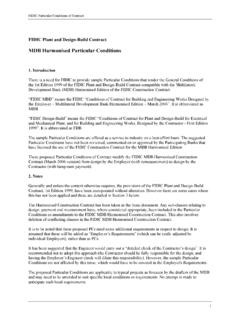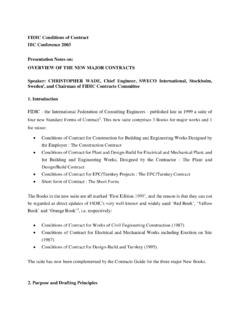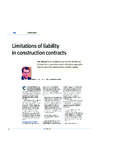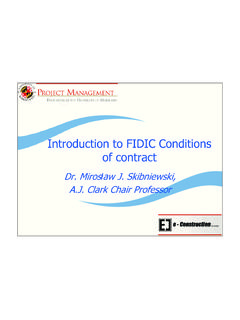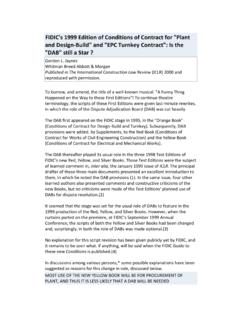Transcription of Article
1 ArticleTurnkey contracting under the FIDIC Silver Book:What do owners want? What do they get?by Jonathan Hosie November 2007 Turnkey contracting under the FIDIC Silver Book: What do owners want? What do they get?Jonathan Hosie IntroductionThis paper concerns turnkey contracting and asks the questions What do owners want? What do they get? The analysis is given a contractual setting by reference to the Conditions of Contract for EPC Turnkey Projects published by FIDIC, otherwise known as the Silver Reference was also made to the ICC Model Contract when this paper was first planned, though the ICC s new Model Contract for Major Projects has not yet (August 2007) been published. The FIDIC Silver Book was produced in 999, in response to a perceived need for a form of contract where certainty of final price, and often of completion date, are of extreme importance.
2 Its publishers also recognised that turnkey projects are popular in project financed deals, where lenders require greater certainty about a project s final costs than is allowed for under contracts that reflect the traditional allocation of risks, such as FIDIC s Red and Yellow Books. The introductory notes to the Silver Book further recognised the practice that prevailed prior to its publication, namely for parties to take the pre- 999 versions of the FIDIC Red or Yellow Books and alter these in order to transfer significant additional risks to the contractor, in an attempt to obtain a higher level of assurance as to outturn cost, quality and paper looks at some aspects of turnkey contracting at the macro level and, in terms of specific features of the FIDIC Silver Book, at certain issues at the micro level.
3 The thesis developed is that owners do not get the turnkey solution they want. This is primarily because a turnkey solution is not as simple as it sounds, due to the inevitable complexities of large projects and the decreased risk appetite of contractors in the global projects arena. There is a shortfall between expectation and actuality in many of the FIDIC provisions, which means that the appearance of risk transfer to the contractor is not as complete as might be suggested by FIDIC s use of the term Turnkey to describe the Silver Book. The views expressed in this paper are personal to the author and are not intended to be imputed to Mayer Brown International LLP or to any client of that FIDIC (International Federation of Consulting Engineers), 999 suite of standard forms (eg Conditions of Contract for Construction (new Red Book), Conditions of Contract for Plant and Design-Build (Yellow Book), Conditions of Contract for EPC Turnkey Projects (Silver Book)), obtainable via Direct quotations from the FIDIC Silver Book in this paper retain the formatting of the original.
4 The ICC Model Contract for the Turnkey Supply of an Industrial Plant was first published in 2003 (ICC Publication 6 , obtainable from ). The ICC s Task Force on turnkey transactions, under the Commission on Commercial Law and Practice (CLP), has drafted the ICC Model Turnkey Contract for Major Projects (due for publication later in 2007), designed to be more suitable for large civil works or for contracts for the supply of plant, where the contractor undertakes to supply a complete facility. Introductory note to First Edition of FIDIC Silver Book (see note 2). See note 2. 2 Turnkey contractingThe idea behind the turnkey approach is, putting it crudely, for the contractor to be given the job to engineer, procure and construct the required works and then, once ready for operations, to hand over the keys to the owner so that it may operate the facility.
5 Turnkey, in principle, means a contract whereby the contractor provides whatever is necessary for a certain contracting is sometimes also referred to as Lump Sum Turnkey or LSTK , emphasising the intended bargain of the parties, with responsibilities allocated to the contractor to deliver the project on time and to a required performance level, in return for payment of a fixed price. A lump sum turnkey price will include contingency allowances to hedge against the risk of things costing more or taking longer to deliver. Owners expect to pay a premium for a turnkey Another acronym seen frequently in this context is EPC: Engineer, Procure and Construct . Thus, an EPC contractor is responsible for the engineering design of the works, its procurement and subsequent Indeed, the Silver Book s full title is Conditions of Contract for EPC Turnkey Projects.
6 Thus it uses the terms EPC and turnkey interchangeably, meaning the same feature of the turnkey approach to contracting, including revenue-generating facilities, is the requirement for the contractor to prove the reliability and performance of the plant and equipment. Thus particular prominence is given in the drafting of turnkey contracts to the testing, commissioning and handover of the works and how this is to be undertaken. Such appproaches are common in process engineering projects, where the output may be energy generation, water treatment, petrochemicals or natural resource processing (mining). It is of critical importance in such projects not only for the project to be delivered within time and cost constraints but also to be delivered so that it is capable of meeting its designed production and output of the asset is particularly key in those turnkey projects funded through project financing.
7 Lenders security is dependent largely on the ability of the completed facility to operate and generate revenue, whether power, chemicals, processed metals or road toll revenue. This prominence is reflected in the General Conditions of the FIDIC Silver Book: the Time for Completion of the works includes not simply completing the works so that the owner can take them over, but also achieving the passing of the Tests on Completion . Against this background, we can start to ask (and suggest some answers to the question): What do owners want? 6 However, it is increasingly common for turnkey contracting to be based on, or involve, an initial cost reimbursable or target cost element. See also notes 7 and 2. The acronym EPCM is also encountered frequently on international projects, but this is very different from EPC.
8 EPCM is a services-only contract, under which the contractor performs engineering, procurement and construction management services. Clause .2 of the FIDIC Silver Book (see note 2). Projects have a large number of moving partsA point worth stressing at the outset is perhaps obvious, but nonetheless important. This is the fact that a turnkey contract will be but one part of the contractual framework and one component of the risk management arrangements and contractual framework used on large projects. Thus, the extent to which risk is allocated to the contractor under turnkey arrangements will depend upon a range of other factors, including the availability and strengths of guarantees from the project s sponsors. Where a sponsor will not provide any, or only a limited form of, completion guarantee to lenders, this obviously increases the need to allocate completion risk away from the sponsor.
9 In these circumstances, the obvious candidate for the risk, given that it will be in the best position to manage it, will be the turnkey contractor. The turnkey contract is the means by which the risk is allocated. A linked point is that projects commonly require a range of skills and products which are not always available from a single turnkey contractor. By way of example, large petrochemical projects may have a series of turnkey contracts for various technologies represented by different process units, plus an infrastructure or utilities turnkey contract. Each process unit will be engineered, procured and constructed by a different turnkey contractor, working alongside each other albeit within the site locations or battery limits of their respective process The key risk in any construction project is completion risk that the works may not be completed: Within the agreed lump sum price; or 2 Within the agreed time scale programme; or To the required performance quality.
10 In a turnkey arrangement, it is the contractor who has responsibility for and control over (at least in theory) each of these elements of completion risk. However, even at this fairly fundamental level, difficulties can be encountered depending upon the sources of information that make up the design for certain plants which may threaten the intended turnkey product the owner is procuring. The idea that turnkey contracting provides the owner (and its lenders) with single-point responsibility is attractive, because it suggests that costly disputes and recourse difficulties when something goes wrong will not be increased by arguments within the supply chain as to who may be at fault. However, and as noted above, large projects will frequently involve a number of turnkey contractors undertaking different parts of the overall project, each according to its own specialist skills.

